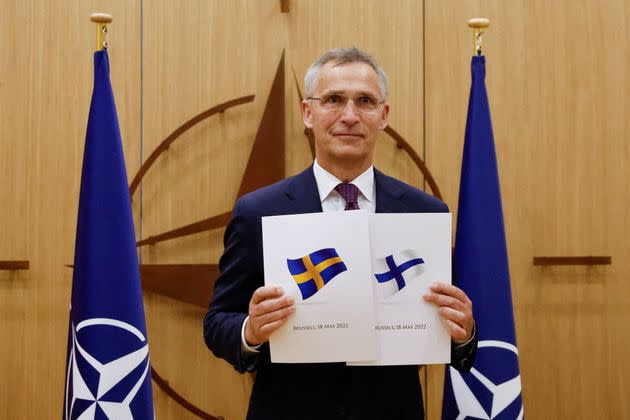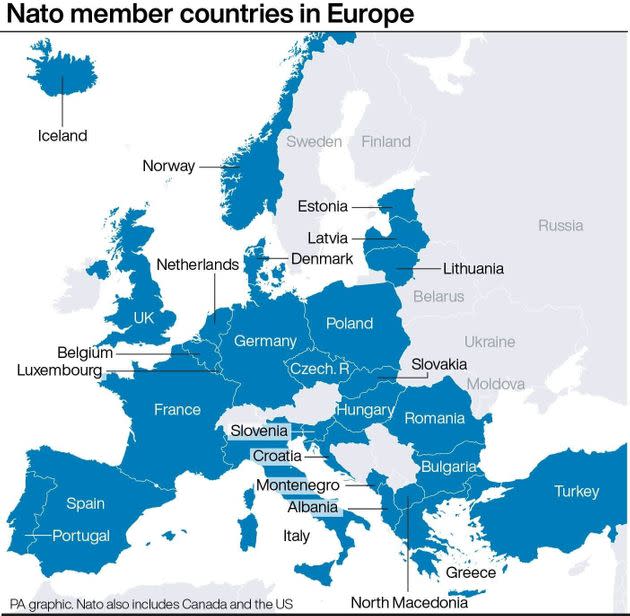Why Have Finland And Sweden Applied To Join Nato?

Nato secretary-general Jens Stoltenberg attends a ceremony to mark Sweden's and Finland's application for membership in Brussels, Belgium. (Photo: Johanna Geron via Reuters)
Sweden and Finland have pushed ahead with their bids to join Nato in the face of Russia’s invasion of neighbouring Ukraine and its ongoing military aggression.
The accession Sweden and Finland, which shares a 1,300-km (810-mile) border with Russia, is expected to take only a few weeks, but faces opposition from member nation Turkey.
Joining the US-led military alliance would mark a radical break in the policy of both north east European countries, underlining once again how Vladamir Putin’s aggression has reshaped the post-Cold War world order. Here are some of the issues that have led to the Nordic rethink about entering the 30-nation group.
What is Nato?
The military alliance goes by the acronym of Nato.
The North Atlantic Treaty Organisation was formed in 1949 to prevent a resurgence of nationalism and militarism in Europe after two world wars, and to deter the Soviet Union’s expansion.
Its membership has swelled to 30 member nations, and over the 1990s and 2000s its enlargement stretched further east to include the former Soviet republics of Estonia, Latvia and Lithuania.
They agree to mutual defence – military action – in response to an enemy attack. The principle goes: “An attack against one ally is considered as an attack against all allies.” This is Article 5 of the Nato constitution.

Nato member countries in Europe. (Photo: PA Graphics via PA Graphics/Press Association Images)
Ukraine is not a member of Nato, which is the main reason why the Western support for Volodymyr Zelenskyy has fallen short of putting their troops on the ground. Ukraine’s admission to Nato has been a stated goal going back to its constitution in 2002, but Ukraine’s president has accepted his country can’t join at present.
Nato’s enlargement has been Putin’s biggest publicly-stated grievance with the West during the build-up up to war, claiming the eastward expansion and potentially sweeping up the largest other former Soviet republic breaks promises.
Adding Sweden and Finland is likely to trigger Putin’s ire too. Moscow has warned it could deploy nuclear weapons and hypersonic missiles in Russia’s Baltic exclave of Kaliningrad – sandwiched between Poland and Lithuania – if they do.
Nato has been adamant it will not accept limits on the nations that it admits and has always maintained an “open door policy”.
What is Finland and Sweden’s position?
Russia’s invasion of Ukraine pushed Finland and Sweden to the verge of applying for Nato membership, a move that would end staunch military neutrality for the two European nations.
The applications will usher in a tense wait during the time it takes to be ratified by all Nato members, though the alliance and the White House have said they were confident any security concerns could be addressed in the interim.
Both countries have been non-aligned militarily since the Second World War, but have been edging towards their current position in response to an increasingly belligerent Russia.
Finland and Sweden switched from formal neutrality to military non-alignment in 1995 when they joined the European Union, and both have drawn closer to Nato in recent years, exchanging intelligence and participating in alliance exercises.
What is ‘Finlandisation’?
Finland gained independence from Russia in 1917 and fought two wars against it during the Second World War, where it lost some territory to Moscow.
Finland signed an Agreement of Friendship, Cooperation, and Mutual Assistance with Russia in 1948, cementing a degree of economic and political dependency and isolating it militarily from western Europe. The strict policy of neutrality is referred to as “Finlandisation”.
The end of the Cold War, bringing a break-up of the Soviet Union, allowed Finland to step out of Russia’s shadow as the threat from Moscow diminished.
It has relied on its own military deterrence and friendly relations with Moscow to keep the peace. But with Russia’s invasion of Ukraine, perceptions of relations with Russia as “friendly” have been undermined.
Opinion polls show support for membership in Finland is high, with people mindful of the long land border it shares with Russia. Support in parliament for an application is also broad.
Sweden’s post-Cold War cuts
Sweden has not fought a war for 200 years and post-war foreign policy has focused on supporting democracy internationally, multilateral dialogue and nuclear disarmament.
It ran down its military after the Cold War, cutting defence spending of up to four percent of its GDP to about one percent during the 1990s and early 2000s.
Despite Putin’s offensive, many on the left in Sweden remain suspicious of the US security agenda and Nato, which ultimately relies on the deterrence provided by America’s nuclear arsenal.
Polls show a substantial majority of Swedes back joining Nato, with support running just above 60% in the latest poll, and there is a majority in parliament in support of an application.
When could they join?
With the applications formally submitted, the Nordic countries and their many backers now face uncertain months where any resistance to their bids must be overcome, with all 30 of Nato’s members needing to approve the enlargement.
Ratification by all allied parliaments could take up to a year, diplomats say.
Turkey has voiced reservations, saying the two countries harbour individuals linked to groups it deems terrorists and hitting out at arms export embargoes imposed on it after its Syria incursion in 2019.
Honoured to receive the applications for #Finland's & #Sweden's membership in #NATO. This is a good day at a critical time for our security. Your applications are an historic step. https://t.co/IH6Vj25FZK
— Jens Stoltenberg (@jensstoltenberg) May 18, 2022
Nato secretary-general Jens Stoltenberg, speaking at a short ceremony at Nato headquarters in which the Swedish and Finnish ambassadors to the alliance handed over their application letters, each in a white folder embossed with their national flag, said: “This is a historic moment which we must seize.
“I warmly welcome requests by Finland and Sweden to join Nato. You are our closest partners, and your membership in Nato will increase our shared security.”
This article originally appeared on HuffPost UK and has been updated.

 Yahoo News
Yahoo News 